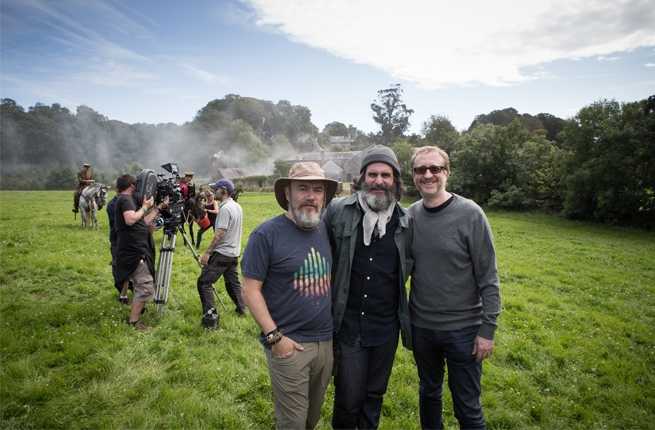In jungles in and around the Don Diego River in Santa Marta, Colombia, the filmmakers of The Lost City of Z re-created the Amazonian jungle, where British explorer Percy Fawcett went on a quest to find a lost nation at the turn of the century, and never returned.
Thankfully, unlike Fawcett (played by Charlie Hunnam in the film) before them, the cast and crew did not get swallowed up by the rainforest. Yet they did spend their days dodging lightning bolts, venomous snakes, and bugs that liked to attach themselves to eardrums.

Filming also took the team to Northern Ireland, where they shot the reenactment of WWI’s Battle of Somme, one of the bloodiest in human history.
Here producer Anthony Katagas lifts the curtain on the filming of The Lost City of Z, and explains why the story is so relevant today. The film opens this Friday in New York and Los Angeles, and everywhere on April 21.
What about David Grann’s book The Lost City of Z drew you to work on this project?
“I found it [to be] a very relevant story. Although it is set at essentially the turn of the century, [contemporary] questions and themes are prevalent throughout. The character of Percy Fawcett, for instance, [was] considered to be ahead of his time, yet still some 100 years later the struggles he faced societally and morally prevail just as strongly today.”
Recommended Fodor’s Video

How did you approach re-creating WWI? How does this era drive the story and scenery?
“In order to recreate the landscape of WW1, we located a large parcel of land owned by a couple of farmers in Northern Ireland, and using the natural grade of the existing land and a bulldozer, we worked the earth into the barren landscape where the battle took place. It took us several months to scorch the earth, bring in trees and scorch them, and build barbed wire fences and bunkers. This huge set enabled us to shoot in most directions without using very many visual effects at all.
“This was historically one of the deadliest battles of the war. It was a senseless, uncivilized display of behavior. One of the central themes of the film is civilization. and more specifically, what constitutes civilized society versus uncivilized society. Ironically, our very sympathetic character Percy Fawcett finds himself in the throes of war and chasing glory at what could be considered an opportunistic time, and we are forced to ask ourselves: would one call this behavior civilized?”
What creature comforts and luxuries did you have to make shooting in the jungle more bearable?
“None. The crew was asked to arm themselves with three vaccines, proper outdoor gear, and most importantly, a headlamp, as the jungle got very dangerous after dark. Most days began at a boat launch, where we would take our boats to our location some 90 minutes up the river. Almost every day, bathrooms were at least 30 minutes away. We were out there in the elements in every sense of the word.”

What were some dangers you and the actors faced on set?
“In addition to venomous snakebites, which seemed to be a daily concern, I would say dehydration and sun exposure were the most common. Periodically, what proved to be the most challenging and dangerous was the sudden rising of the river. If there was a storm 2-3 hours up in the mountains, we knew it was only a matter of minutes before water came rushing down and affected the river's water levels dramatically. In some cases, the river rose on us 12 feet, wiping out several sets that had to be rebuilt the next day with the same risk. When this would happen, and it happened a few times, the river was moving so fast and rapidly that the only way to get back to base camp was to walk for some three hours. Additionally, these rainstorms would randomly bring intense thunder and lightning. We saw lightning strike within 100 feet of us on several occasions.”

Which actor is most afraid of bugs?
“I witnessed on many occasions, actors catching rest where one could, which included sitting right down in the jungle and making the decision that bugs crawling all over them was a small price to pay for a little R&R when one could find it on our grueling schedule. The actors were true professionals dealing with bugs (or worse) on a daily basis. I do recall the time when Charlie Hunnam had to have a bug removed from his eardrum, however I wouldn’t be so quick to say that he was at all scared of the little fella.
What regional drinks or cuisine did you try when you were filming?
“I was a fan of fresh fried fish, whole. There were two serene surf beach stopovers that I remember were charming and to everybody’s surprise had a terrific little bar that served fresh seafood. There was also a tiny beach called Los Angeles where a mom and pop-operated concession stand blended beautiful juice drinks and cocktails while one could watch surfers have at it.”

Would you ever go back to the jungle?
“Yes I would go back. There seems so much more to see; one rarely gets to know the true treasures of a location while filming a movie because [during] filming, you’re there to do a job day in, day out. I’d like to go down without having to work and spend a few weeks taking it in.”
What were some of the limitations of shooting a film in the jungle?
“Electricity/power was almost never available, forcing us to work very carefully around time of day, using sun and open flame and the jungle’s canopy as our lighting equipment. Working on or around water is also always a challenge, but the biggest challenge proved to be developing the film stock. We shot Kodak stock on this picture, and working with delicate negative in the very hot and humid jungle presents one set of challenges after the next—not only handling film in the jungle, but then getting the exposed film stock out of the country and back to UK eight days later.”
Plan your trip with Fodor’s Santa Marta guide.




